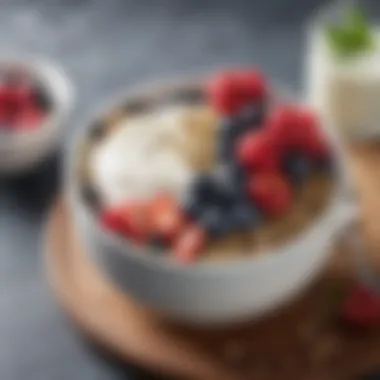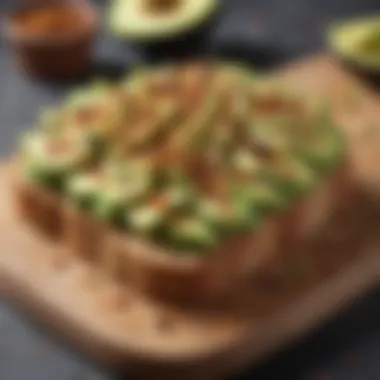Delicious Healthy Snacks for Effective Weight Loss


Intro
In today’s fast-paced world, finding healthy snacks that aid in weight loss can often feel like a challenge. Many snacking options are packed with excessive sugars or unhealthy fats, making the quest for healthier alternatives essential. This section will explore creatively nutritious recipes that not only satisfy cravings but also contribute positively to weight management. It's vital to understand that snacks can play an integral role within the framework of a balanced diet. The focus should be on nutrient-dense options that keep you feeling full while participating in your weight loss journey.
Recipe Overview
Crunchy Chickpea Snacks: Baked to Perfection
- Portions: 4 servings
- Total Time: 35 minutes (15 minutes prep, 20 minutes cooking)
- Difficulty: Easy
- Main Ingredients:
- 1 can of chickpeas (drained and rinsed)
- Olive oil
- Salt
- Smoked paprika
- Garlic powder
This recipe also showcases other beneficial flavors through spices, enhancing not only the nutrition but the overall taste experience. Chickpeas are a fantastic source of protein and fiber and will help keep you satiated between meals.
Step-by-Step Instructions
- Begin by preheating your oven to 400°F (200°C).
- Drain and rinse the can of chickpeas well.
- Spread them on a towel and pat dry for about two minutes to ensure they become crisp.
- In a mixing bowl, combine the dried chickpeas with olive oil, salt, smoked paprika, and garlic powder.
- Transfer the mixture onto a baking sheet, spreading it out evenly.
- Roast the chickpeas in the oven for about 20 minutes or until they are browning and crunchy.
- Enjoy them immediately for the best flavor and texture.
Time-saving Tip: If you have limited time, try using pre-cooked chickpeas from the store. They can save about 10 minutes on prep.
Nutritional Information
- Calories per serving: Approximately 120
- Nutritional Breakdown:
- Protein: 6 grams
- Fats: 4 grams
- Carbohydrates: 18 grams
Highlight Nutrients: Chickpeas are rich in fiber and protein. They support digestion and can help maintain muscle mass during weight loss. Additionally, they are low in fat, making it an excellent snacking option.
Quick Cooking Tips
- Utilize Air Fryers: These convenient gadgets can reduce cooking time and give you an even crispier snack without adding excess oil.
- Multitasking: While the chickpeas bake, you can prepare a fresh vegetable dip or another snack. This usage of time can streamline your kitchen tasks.
- Room for Variability: Feel free to experiment with spices such as cumin or cayenne, depending on your flavor preference.
Related Recipes & Variations
For a more diverse snacking option, consider pairing crunchy chickpeas with:
- Homemade Hummus: Easily whip up a smooth dip using chickpeas, tahini, lemon, and garlic, perfect for additional servings.
- Roasted Mini Peppers: An easy complementary dish that can also incorporate plenty of spices.
Experimenting and sharing variations of recipes energizes the cooking experience. Share what adjustments you have made with the snacks and explore ideas from others on platforms such as redditt.com.
Healthy snacks help maintain energy levels, contributing to better food choices later in the day.
Understanding Healthy Snacking
Understanding healthy snacking is a crucial aspect of effective weight management. Many individuals often regard snacking as a guilty pleasure, leading to mindless eating habits that can undermine their goals. In reality, snacks play an important role in maintaining energy levels and should not be demonized. A deeper comprehension of what healthy snacking entails can provide clarity on its significance in leading a balanced diet.
Furthermore, healthy snacking allows for increased nutrient intake, particularly when choices consist of fresh, whole foods. They can bridge the gap between meals, helping to stave off hunger and avoid overeating during main meals. Therefore, it is essential to explore this concept fully to understand better how it can impact healthy eating habits and promote weight loss.
Defining Healthy Snacks
Defining healthy snacks begins with recognizing that not all snacks are created equal. A healthy snack is one that provides nutritional value without excessive calories, sugar, or unhealthy fats. Typical examples include fruits, vegetables, nuts, yogurt, and whole grains. These options furnish essential vitamins, minerals, and fibers that are beneficial for overall health.
On the contrary, many convenience snacks tend to be high in added sugars and empty calories, causing fluctuations in blood sugar and cravings. Thus, discerning what qualifies as a healthy snack is pivotal for anyone interested in weight management and overall well-being.


The Role of Snacks in Weight Loss
The role of snacks in weight loss is often underestimated. When approached thoughtfully, snacking can be metabolically advantageous. Snacks can sustain energy levels across the day, preventing fatigue that might lead to unhealthy food choices later.
Integrating healthy snacks into one's diet can control appetite, resulting in smaller portions during meals. Moreover, consumشنig small, nutrient-dense snacks has been shown to offset nutrient deficiency which could occur with strict diets. Thus, sound snacking aids those on weight loss journeys by supporting both metabolic needs and dietary preferences.
Common Misconceptions About Snacking
There are several misconceptions about snacking that can hinder progress. A prevalent belief is that all snacking contributes to weight gain; however, the quality and quantity vastly influence the outcome. For example, consuming instead of cookies, an apple with almond butter provides a nutrient dense choice with that satiates hunger effectively.
Additionally, people might often think that they should avoid snacks entirely to lose weight. Yet, judicious snacking can, in fact, work in favor of those pursuing a healthier lifestyle.
Healthy snacking is not merely a small meal; it serves a functional role in weight loss and overall health when chosen wisely.
Nutritional Components of Effective Snacks
The significance of nutritional components in snacks cannot be overstated. Understanding these elements allows one to make informed choices. For the purpose of weight loss, snacks should not simply fill a void but provide sustenance that keeps the body nourished while aiding in energy management. This section will dive into the specific composition of healthy snacks and examine their role in a weight management strategy.
Macronutrients to Consider
When thinking about snacks, macronutrients are a fundamental consideration. These include carbohydrates, proteins, and fats. Each plays a unique role in supporting the body's needs and functions.
- Carbohydrates: They provide quick energy but can cause spikes in blood sugar if chosen poorly. Opting for complex carbohydrates, such as whole grains, lends lasting energy without drastic fluctuations.
- Proteins: A crucial element for muscle preservation, protein increases satiety. Choosing snacks like Greek yogurt, nuts, or cottage cheese can help maintain fullness between meals.
- Fats: Healthy fats, such as those found in avocados or olive oil, support satiety. They also assist in nutrient absorption and provide extended energy.
Overall, balancing these macronutrients can lead to better energy levels and contribute to weight-loss success.
Importance of Fiber and Protein
Fiber and protein merit special attention in snack choices. Fiber promotes digestive health and optimal gut function. Including high-fiber snacks like raw vegetables or whole-grain crackers can slow digestion, helping a person feel full longer.
Protein, on the other hand, assists in muscle retention and metabolic efficiency. Snacks that contain a combination of fiber and protein are particularly effective for weight loss. For example, pairing apple slices with almond butter merges the benefits of fiber with protein’s satiating properties. This combination helps to curb hunger, providing lasting energy without excessive caloric intake.
Both nutrients hold an indispensable role in overall health and effective snacking practices.
Hydration and Snack Choices
Hydration is often overlooked when discussing snack choices, yet it profoundly impacts weight control and overall well-being. Sometimes, the body may misinterpret signals of hunger when it is, in fact, dehydrated. Staying hydrated is crucial. It aids in digestion and supports nutrient transport within the body.
Incorporating hydrating snacks can be a clever way to help maintain fluid balance.
- Water-rich fruits such as watermelon and cucumber can effectively contribute to hydration.
- Flavoring plain water with slices of citrus or strawberries enhances both the refreshment and appeal.
Overall, understanding hydration contributes to calorie awareness, ensuring that fluid intake does not get overlooked while snacking. Balancing the nutritional profile of your snacks can, in turn, support effective weight loss and adherence to a healthier lifestyle.
Quick and Easy Snack Recipes
Quick and easy snack recipes offer several advantages in the context of weight loss. Preparation speed is crucial for busy lifestyles. Healthy snacks done right can help curb hunger between meals and contribute positively to overall nutrition. These recipes are both convenient and desirable, easy to prepare with readily available ingredients. Keeping recipes simple yet nutritious can help maintain portion control and promote mindful eating.
Vegetable-Based Snacks
Raw Veggies with Hummus
Raw veggies with hummus serve as an appealing snack option for many reasons. They provide a great mix of nutrients that support weight loss. The high fiber content in vegetables keeps you full, reducing the temptation to indulge in less healthy options. Hummus adds richness and flavor without overwhelming calories. A key characteristic of this combo is its immediacy; grabbing cut vegetables just takes seconds.


A unique feature of this snack is its versatility. Carrots, cucumbers, and bell peppers can be paired with various hummus flavors. This variety can prevent snack fatigue. However, it is essential to watch the portion of hummus, as calorie counts can stack up if overindulged.
Stuffed Bell Peppers
Stuffed bell peppers create a satisfying snacking experience that also offers nutritional benefits. This snack showcases the bell pepper's inherent crunchiness paired with a filling. The stuffing can be a mix of grains or proteins, accommodating diverse dietary preferences. Its customizable nature makes it popular. Individuals enjoy creating different flavor profiles based on preferences.
One significant advantage of stuffed bell peppers is their high hydration content, often overlooked. When consuming gastrointestinal-friendly options along with healthy filling, it may boost satiety levels. Nevertheless, individual preferences and personal goals generally color how this snack could fit into a diet.
Fruit-Inspired Options
Yogurt and Berries
Yogurt and berries make for a vibrant and nutrient-dense snack, combining probiotics and antioxidants. This snack supports gut health, important in any weight-loss regimen. The yogurt offers creaminess which contrasts wonderfully with the fresh texture of the berries. The dish can easily be tailored for personal taste. Regular yogurt or Greek can be chosen, adding versatility.
How to Prepare Snacks Efficiently
Efficient preparation of snacks plays a crucial role in integrating healthy eating into our fast-paced lives. When we prioritize snacks rightly, we can minimize temptations from unhealthy options while feeling satisfied throughout the day. By implementing effective strategies, we make healthier eating effortless, which is essential for those aiming to lose weight.
Meal Prepping Strategies
Meal prepping is an essential skill that allows individuals to adhere to their dietary goals. Setting aside time each week to prepare snacks helps ensure that healthy options are readily available. One technique to begin is to select a day where some few hours can al be focused solely on preparation. Map out a few recipes that align with your nutritional needs and tastes.
Key considerations include:
- Selecting Nutritious Ingredients: Choose high-fiber vegetables and lean proteins that can efficiently fuel your body.
- Batch Preparation: Multiplying recipes helps save you time. You can prepare a single recipe in larger quantities to last through the week.
- Portion Control: Use divided containers to portion bites accordingly. This can prevent overeating and maintains portion control throughout the week.
Utilizing Batch Cooking
Batch cooking ensures that a significant amount of snacks is prepared in one go. This requires a bit of planning but results in multiples servings of healthy dietodes. When deciding on which snacks to prepare, focus on combinations that complement each other nutritionally and flavor-wise. Products like veggie sticks and hummus or overnight oats with chia seed can tap into enriching flavors while providing long-term satisfaction.
To effectively utilize this method:
- Choose Recipes Wisely: Focus on snacks that store well, like hard-boiled eggs or homemade granola bars.
- Inventory Management: Post-cooking, you should categorize snacks into groups to avoid duplication. Assign storage units for different types. Organization is essential.
Storage Solutions for Freshness
How you store snacks has a direct impact on their longevity and integrity. Proper containment methods prolong the shelf-life of fresh produce, whole grains, and proteins ensuring every bite retains quality.
A few effective storage solutions include:
- Air-tight Containers: Ensures moisture and air exposure remain minimal, thus protecting crisp snacks from becoming stale.
- Freezer Storage: For snacks that freeze well, such as trail mix or smoothies, store them freezer-safe containers to keep nutrients intact.
- Labels: Systematically lable items with food added or prep date. This practice keeps track of freshness visibly leaving no need for guesswork.
"Effective preparation and storage are pillars of successful healthy snacking, preventing common risks associated with impulsive eating decisions."
In summary, efficiently preparing snacks through meal prepping, batch cooking and adequate storage solutions creates an effective framework for healthful eating habits that can sustain an individual's weight loss goals.
Incorporating Snacks into Your Diet
The integration of snacks within a dietary plan can influence the overall effectiveness and satisfaction of a weight loss strategy. Properly incorporating snacks can help maintain energy levels, avoid extreme hunger, and promote healthier choices throughout the day. Recognizing the right moments to snack, the types of snacks chosen, and understanding individual portion requirements are all fundamentals in this aspect.
Understanding Portion Control
Portion control is critical in the realm of snacking, particularly for weight management. Unlike meals that are typically more structured, snacks can sometimes lead to unconscious overeating, especially when sitting in front of screens. To effectively manage portion size, consider using smaller plates or containers when serving snacks. Additionally, teaching the mind to acknowledge the signals of hunger and fullness is vital. Here are some tips:


- Measure servings: Use measuring cups to understand the actual portion size of commonly enjoyed snacks.
- Be mindful: Eat snacks without distractions to maintain awareness of consumption.
- Do not eat straight from the package: Transfer snacks into a bowl to prevent mindless eating.
Incorporating these practices can prevent accidental overindulgence and help sustain energy without adding excessive calories.
Mindful Snacking Practices
Mindful snacking encompasses a thoughtful approach to choosing and consuming snacks. This practice emphasizes conscious decisions regarding both what and how one engages with small meals. People often eat snacks on autopilot, failing to take notice of tastes and textures or even the many health benefits they may provide. Gentle steps towards more mindful snacking include:
- Pick healthy options: Opt for whole foods like almonds or carrots that boast nutritional value.
- Enrich your experience: Take time to appreciate flavors and textures as you eat.
- Focus on frequency: Schedule specific times for snacks to help reduce impulse eating that may lead to poor choices.
By adopting mindful snacking practices, individuals can transform potentially mindless nibbling into fulfilling and nutritionally beneficial propositions.
Timing Your Snacks for Optimal Energy
Understanding when to snack can profoundly affect performance and energy throughout the day. Timing snacks to coincide with periods of increased activity or dips in productivity not only enhances well-being but also boosts weight loss efforts. Consider the following guidelines regarding timing:
- Post-workout replenishment: After physical activity, consume protein-rich snacks like a smoothie or Greek yogurt. This helps repair muscles and support recovery.
- Pre-meal mitigation: Consider having a light snack before meals to stave off excessive hunger; this facilitates better choice-making during main meals.
- Maintain consistency: Regular intervals of eating can stabilize blood sugar levels, aiding both focus and satiety.
With these timing strategies, snacking transforms from a potential pitfall into a beneficial practice that bolsters overall health and weight loss effectiveness.
By thoughtfully incorporating snacks into one's diet, it is possible to find a balance between flavor and nutrition that supports weight management without sacrificing enjoyment.
Potential Pitfalls of Snacking
Snacking is often seen as a minor component in weight management, but it can significantly influence overall dietary success. Recognizing and understanding common pitfalls provides a strategic advantage. For many, snacking is not merely about hunger—it's woven into daily habits. When making healthy choices, it is crucial to approach snacking with awareness.
Overindulgence and Emotional Eating
Emotional eating can complicate healthy snacking. Driven by feelings rather than hunger, this behavior often leads to excessive intake of calories. Individuals may find themselves reaching for snacks during stress or anxiety rather than genuine physical need. This can result in choosing calorie-dense, nutrient-poor options.
To break this cycle, some practical steps can be employed:
- Identify triggers. Keep a food journal to note emotions tied to eating.
- Develop alternative coping mechanisms. Gentle exercises or relaxation techniques can deter the need for snacks when feeling overwhelmed.
- Practice portion control. This fosters a more mindful approach, making it easier to ascertain true hunger signals.
Epilogue
In evaluating the landscape of healthy snacking, it is crucial to underscore how these dietary choices can significantly aid weight loss strategies. Focusing on nutritious options contributes to a balanced lifestyle, providing the necessary fuel without excessive caloric intake. This key element empowers individuals to maintain energy levels, manage their weight effectively, and promote overall well-being.
Summarizing Healthy Snacking Essentials
Healthy snacking is not simply about indulging in low-calorie treats; it is about making informed choices that satisfy hunger and nourish the body. Knowledge of essential nutrients plays a pivotal role in this practice. Understanding which snacks are beneficial needs one to look at their nutritional profiles. Strong candidates typically include a balance of protein, fiber, and healthy fats. These components work in orchestrating the pacing of energy release and feelings of satiety.
Here are several essentials to summarize:
- Balance Nutrients: Aim for options combining proteins, carbohydrates, and healthy fats.
- Frequency: Moderate snacking can stave off hunger and maintain energy in between meals.
- Portion Size: Small amounts can prevent overindulgence and help stay within caloric limits.
By keeping these fundamentals in mind, broader dietary goals become more accessible and achievable.
Encouraging Practical Snacking Techniques
Incorporating practical snacking techniques can help integrate these healthy choices into daily life seamlessly. It isn't only about preparing tasty snacks; it involves ensuring they fit life’s fast pace. Here are a couple of practical recommendations:
- Prepare Ahead: Meal prepping can save time and maintain variety in your snacks. Spend some time once a week to cut vegetables or portion out nuts.
- Mindful Selection: When shopping, focus on whole foods. Read nutritional labels carefully to distinguish between processed snacks and nutrient-rich options.
Use containers to portion snacks, will help carry positive habits outside of the home! By implementing these strategies, individuals can ease the transition towards healthy snacking habits.
Healthy snacks are a bridge between meals that can sustain energy and prevent hunger, delivering a viable path to achieve weight management.
Being proactive about snack choices enables one to grasp control of their dietary journey.







